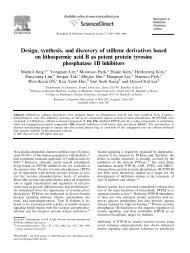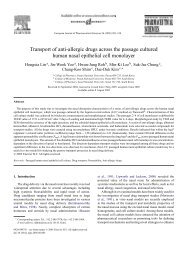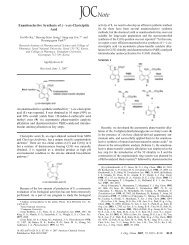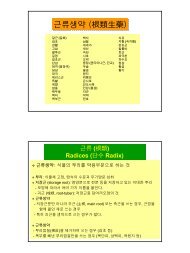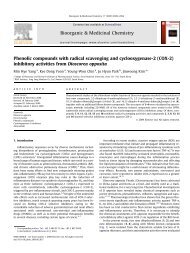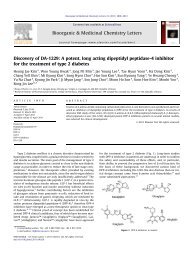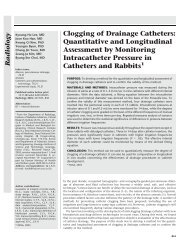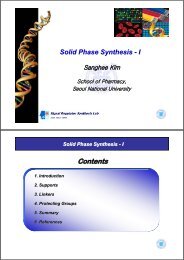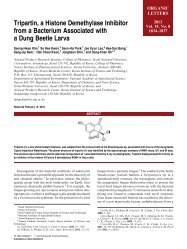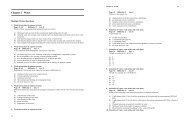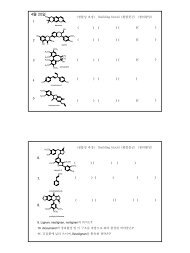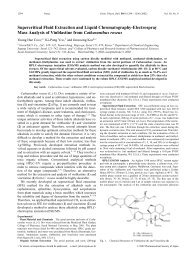Chemical Constituents of Abies koreana Leaves with Inhibitory ...
Chemical Constituents of Abies koreana Leaves with Inhibitory ...
Chemical Constituents of Abies koreana Leaves with Inhibitory ...
- No tags were found...
Create successful ePaper yourself
Turn your PDF publications into a flip-book with our unique Google optimized e-Paper software.
cm −1 ; 1 H-NMR (600 MHz, CD 3 OD) : δ 8.1 (2H, d,1510= 9.0 Hz, H-2' and H-6'), 6.9 (2H, d, J = 9.0 Hz, H-3'JH-5'), 6.4 (1H, d, J = 1.8 Hz, H-8), 6.2 (1H, d, J = 1.8andH-6), 5.3 (1H, d, J = 7.8 Hz, H-1''), 3.2~3.9 (5H, m,Hz,158.6 (C-2), 137.3 (C-3), 132.4 (C-2'), 132.4 (C-(C-9),122.9 (C-1'), 116.2 (C-3'), 116.2 (C-5'), 104.3 (C-10),6'),(C-1''), 94.9 (C-8), 78.6 (C-3''), 78.2 (C-5''), 75.9100.071.5 (C-4''), 62.8 (C-6'').(C-2''),(7) − Brownish oil; FAB MS m/z : 361Isolariciresinol +; [α] 20 D : 68.0 (c 1.0, Me 2 CO); UV λ max (MeOH)[M+H]: 220, 285; IR ν max (KBr): 3350, 1600, 1500 cm −1 ; 1 H-nm(600 MHz, CD 3 OD) : δ 6.7 (1H, d, J = 8.0 Hz, H-NMR6.7 (1H, d, J = 1.4 Hz, H-2), 6.6 (1H, s, H-2'), 6.6 (1H,5),J = 1.5, 8.0 Hz, H-6), 6.2 (1H, s, H-5'), 3.8 (1H, d,dd,= 10.7 Hz, H-7), 3.8 (3H, s, 3'-OCH 3 ), 3.8 (3H, s, 3-J3 ), 3.7 (1H, m, H-9'), 3.7 (3H, dd, J = 3.8, 10.8 Hz,OCHb -9), 3.4 (1H, dd, J = 4.0, 11.2 Hz, H a -9), 2.8 (2H, d,H= 7.7 Hz, H-7'), 2.0 (1H, m, H-8'), 1.8 (1H, m, H-8);JC-NMR (150 MHz, CD13OD) : δ 149.1 (C-3), 147.3 (C-3146.0 (C-4), 145.4 (C-4'), 138.7 (C-6'), 134.3 (C-1),3'),(C-1'), 123.3 (C-6), 117.5 (C-5'), 116.1 (C-2), 113.9129.1112.5 (C-2'), 66.1 (C-9'), 62.4 (C-9), 56.5 (OCH 3 ),(C-5),(OCH 3 ), 48.2 (C-8), 48.13 (C-7), 40.14 (C-8'), 33.756.5(C-7').(8) − Brownish oil; FAB MS m/z :Secoisolariciresinol[M + H] + ; [α 20 D : -16.0 (c 0.10, MeOH); UV λ max363nm : 226, 281; IR ν max (KBr): 3425, 1516 cm −1 ;(MeOH)1(400 MHz, CD 3 OD) : δ 6.7 (2H, d, J = 7.9 Hz,H-NMRand H-5'), 6.6 (2H, d, J = 1.9 Hz, H-2 and H-2'), 6.5H-5dd, J = 7.9, 1.9 Hz, H-6 and H-6'), 3.7 (3H, s,(2H,3 ), 3.6 (4H, m, H-9 and H-9'), 2.6 (2H, dd, J = 13.6,OCHHz, H b -7 and H-7'), 2.5 (2H, dd, J = 13.6, 7.7 Hz, H a -7.0and H-7'), 1.9 (2H, m, H-2 and H-3); 13 C-NMR7MHz, CD 3 OD) : δ 149.5 (C-3), 149.5 (C-3'), 146.1(100146.1 (C-4'), 134.6 (C-1), 134.6 (C-1'), 123.4 (C-(C-4),123.4 (C-6'), 116.6 (C-5), 116.6 (C-5'), 113.9 (C-2),6),(C-2'), 62.8 (C-9), 62.8 (C-9'), 57.0 (OCH 3 ), 57.0113.93 ), 44.8 (C-8), 44.8 (C-8'), 36.7 (C-7), 36.7 (C-7').(OCH(9) − Whitish powder; EIMS m/z : 166Rhododendrol +; UV λ max (MeOH) nm : 214.5, 276; IR ν max (KBr):[M]H-7 and H-9), 3.8 (1H, m, H-2), 2.6 (1H, t, J = 7.0Hz,H-4), 1.7 (1H, m, H-3), 1.2 (3H, d, J = 6.3 Hz, CH 3 );Hz,C-NMR (75 MHz, CD13OD) : δ 157.1 (C-8), 135.2 (C-3131.0 (C-6), 131.0 (C-10), 116.8 (C-7), 116.8 (C-9),5),(C-2), 43.2 (C-4), 33.0 (C-3), 24.3 (CH 3 ).68.7acid (10) − Yellowish powder; EI MS m/z :FerulicMHz, CD 3 OD) : δ 7.6 (1H, d, J = 15.9 Hz, H-7), 7.1(300d, J = 2.0 Hz, H-2), 7.0 (1H, dd, J = 8.1, 1.8 Hz, H-(1H,6.9 (1H, d, J = 8.1 Hz, H-5), 6.3 (1H, d, J = 15.9 Hz,6),2.9 (3H, s, OCH 3 ); 13 C-NMR (75 MHz, CD 3 OD) : δH-8),(C-9), 153.9 (C-3), 150.5 (C-7), 149.1 (C-4), 131.5173.3125.1 (C-6), 119.1 (C-5), 117.3 (C-8), 115.0 (C-2),(C-1),(OCH 3 ).58.8(11) − Brownish oil;4-(4-hydroxyphenyl)butan-2-oneMS m/z : 164 [M] + ; UV λ max (MeOH) nm : 224, 278;EIν max (KBr): 3360, 3020, 2920, 2870, 1685, 1620,IR1510, 1440, 1365, 1320, 1290, 1225, 1170, 1105,1600,960, 875, 830, 765, 730 cm −1 ; 1 H-NMR (500 MHz,1040,3 OD) : δ 7.0 (2H, d, J = 8.3, H-6 and H-10), 6.8 (2H,CDJ = 8.3, H-7 and H-9), 2.8-2.7 (4H, m, H-3 and 4), 2.1d,s, CH 3 ); 13 C-NMR (125 MHz, CD 3 OD) : δ 210.0 (C-(3H,154.5 (C-8), 132.6 (C-5), 129.5 (C-6, 10), 115.6 (C-7,2),45.6 (C-3), 30.3 (CH 3 ), 29.1 (C-4).9),<strong>of</strong> BV2 microglial cells − BV2 microglialCulturewere provided by Pr<strong>of</strong>. Sun-yeou Kim, at KyungcellsUniversity (Suwon, Korea). The cell line wasHeein DMEM containing 10% FBS <strong>with</strong>maintained(100 IU/mL) and streptomycin (10 mg/mL) atpenicillinoC in a humidified atmosphere <strong>of</strong> 95% air-5% CO 2 .37for inhibition <strong>of</strong> nitric oxide production − ToAssayany trace <strong>of</strong> phenol red, the cell cultures wereremoveand the medium was replaced <strong>with</strong> Griesswashedand further incubated <strong>with</strong> test samples and LPS.medium24 hrs incubation, 100 ul aliquots <strong>of</strong> sample wereAfter<strong>with</strong> 100 µl <strong>of</strong> Griess reagent (1% sulfanilamidemixed0.1% naphtylethylenediamine dihydrochloride, 2%andacid) in a 96 well plate and incubated at roomphosphoricfor 15 min. The absorbance at 550 nm wastemperatureon a microplate reader. The concentration wasmeasuredusing a nitrite standard curve (Dawson et al.,determined1994)viability measurements using the MTT assay −Cell100 µl aliquots <strong>of</strong> sample were collected for GriessAfterMTT (0.2 mg/mL) was directly added to cultures,assay,by incubation at 37 o C for 3 hrs. The supernatantfollowedthen aspirated and 100 µl <strong>of</strong> DMSO was added towasthe formazan. After insoluble crystals weredissolvedissolved, absorbance (abs) at 540 nm wascompletelyusing a microplate reader. Data were expressedmeasuredpercent cell viability relative to control cultures.as178 Natural Product Sciences[M] + ; UV λ max (MeOH) nm : 242, 293, 323; IR ν max1943427, 2921, 1620, 1516, 1432 cm −1 ; 1 H-NMR(KBr):3'', 4'', 5", 6''); 13 C-NMR (150 MHz, CD 3 OD) : δH-2'',(C-4), 166.1 (C-7), 163.2 (C-5), 161.7 (C-4'), 159.2179.71595, 1500 cm −1 ; 1 H-NMR (500 MHz, CD 3 OD) : δ3330,(2H, d, J = 8.4 Hz, H-6 and H-10), 6.7 (2H, d, J = 8.47.0Cell viabiltity (%) = 100 ×(Abs <strong>of</strong> LPS-treated or LPS + saple-treated)Abs <strong>of</strong> control



